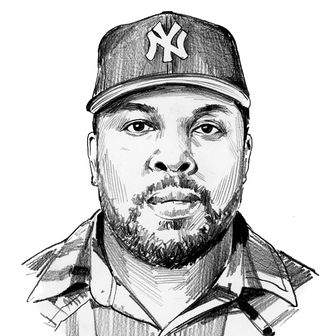
Harry Styles is a student of rock and roll, and it shows. He keeps a legend as a close friend. He can quote specific passages of old David Bowie interviews. His fashion sense is indebted to the glam-rock era. His 2017 self-titled solo debut outfoxed the pop and R&B projects crafted by his former mates in One Direction by getting out of the game of chasing trends. Harry Styles is the product of a band of brothers piecing together a sound that looked beyond the charts for inspiration. The first album wasn’t perfect — lad rock moments and overt Rolling Stones posturing weighed it down in the midsection — but transcendent tunes like “Ever Since New York,” “Sign of the Times,” and “Woman” escaped the shadows of their influences. On his second album, Styles picks up more lessons from his heroes.
Fine Line backs off of some of the folky Beatles affectations of the first album, reworking the mix to house more and different flavors. Where 2017’s Styles resembled 1970’s McCartney, the largely acoustic self-titled debut where Sir Paul’s band broke up and he proved he didn’t need the others or the bells and whistles they favored to make a splash, Fine Line is more like 1979’s Back to the Egg, the Wings album where McCartney and the new band get loose and try a little of everything, seating rock workouts like “Old Siam, Sir” next to funk jams like “Arrow Through Me” and letting fans make sense of the clashing sounds on their own. Fine Line opens inauspiciously with “Golden,” where Styles and his pals try out the freight train emotional heft of Fleetwood Mac and turn in a tune even keener about the task than the Lady Antebellum song of the same name that the real Stevie Nicks guested on. From there, for better or worse, the album goes where it pleases.
Fine Line sees Styles realizing there’s room in a classic-rock rubric for more than folk and blues sounds. Early on, the singles “Watermelon Sugar,” “Adore You,” and “Lights Up” traffic in upbeat tempos and lean funk-pop grooves, to varying effects. Scheduled in a row, it’s too much of the same idea, and it threatens to turn the album’s front half into a Maroon 5 record, with the expected grating but almost intrusively catchy hooks. “Watermelon Sugar” distinguishes itself with tight vocal harmonies and a killer brass section toward the end. “Lights Up” turns out to be even sturdier on the 50th play than the first handful could’ve insinuated. “Adore You” is one too many. In spite of a cool guitar solo, it gives the sense that Styles could dream up serviceable dance-pop tunes like these in his sleep but is better served for not wanting to, considering how iffy of a fit slick, faceless pop music has been for his contemporaries. “Falling,” the winsome breakup tune that closes the first side, is the outlier, a ballad that’s both sort of middle of the road and also hooky and heartbreaking enough to deserve the kind of airplay the big Lewis Capaldi weeper got this year.
The album wanders off the beaten path in its second half, and it’s off to the races. “Sunflower, Vol. 6” and “To Be So Lonely” get restless, mining sounds from around the world the same way the latest Vampire Weekend album does. The former taps producer Greg Kurstin for an absolutely batshit performance on clavichord that gives the song a blend of playfulness and unbeatable musicality that suggest a few clandestine Frank Zappa fans in the mix. “To Be So Lonely” is an exquisite downer whose low end is fleshed out gorgeously with a dollop of cello. “She” revisits the jilted mood of “Woman,” subbing in heavy Pink Floyd influence in place of reverence for Beatles bangers like “I Want You (She’s So Heavy).” “She” is worth the price of admission for the long guitar duel between Styles’s bandmates Kid Harpoon and Mitch Rowland, which comes to a dramatic halt just as it starts to really boil, like “Shine on You Crazy Diamond,” from Floyd’s 1975 classic Wish You Were Here. You think that’s as feisty as this band is going to get, and they spin out even further on “Treat People With Kindness,” a bubbly rock tune with an overbearing crowd vocal about being good to one another that seems like the core message amid this album’s musings on loneliness, and the title track, where Fine Line’s disparate interests in sad songs, acoustic numbers, slow-burning crescendos, bursting horn and string arrangements, and intricate vocal harmonies finally come together.
There are two threads here. There’s Harry Styles the pop star, whose task is following a successful first album as a solo artist with another package of hits and buried treasures, and there’s Harry Styles the last rock star, intrepid band leader and music scholar sewing a proverbial Technicolor dream coat out of bits of threads worn by his heroes. Fine Line supposes that these are dueling interests and honors them one at a time, shifting woozily from breezy radio-friendly fare to inspired band experiments and folk songs like “Cherry” that approach matters of the heart more nakedly and house the album’s most literal and personal lines. (The one about “walking ‘round his parents’ gallery” is a dig at Harry’s ex Camille Rowe’s new man Theo, heir of Greek shipping magnate Stavros Niarchos. The song ends with a snippet of Rowe’s voice, in French.)
It’s an interesting approach, considering that the magic of his debut album hits like “Sign of the Times” was that they scratched Styles’s commercial and artistic itches in one gesture. If he wanted, Styles could lean into the unfettered artistry that Fine Line’s title track and closer suggests he’d be great at, or keep introducing the youth to the classics of the ’70s, or continue the push into adult contemporary pop that 1D’s Made in the AM initiated. The success of this year’s Jonas Brothers reunion is proof grown up boy band fans will still bite if the bait is tasty enough. Fine Line wants it all, but the pieces don’t always jibe. Harry’s still trying to find himself; what’s clear among the many highlights here is that he deserves more time and refinement.
*A version of this article appears in the January 6, 2020, issue of New York Magazine. Subscribe Now!





